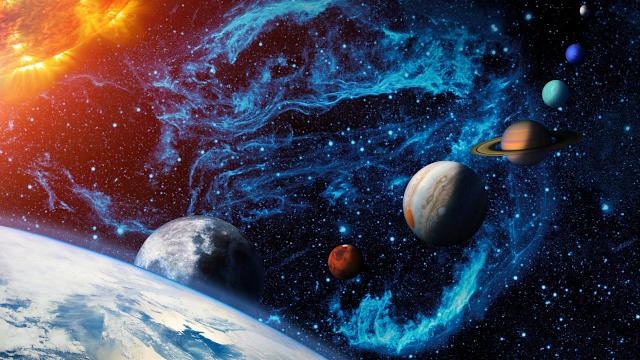The James Webb Space Telescope is one of the most advanced and modern research tools in space. Developed by NASA, with support from the European Space Agency and the Canadian Space Agency, this project is set to significantly change the future of astronomy. As the successor to the Hubble Space Telescope, it is equipped with more advanced technology and broader capabilities. The James Webb Space Telescope operates in the infrared spectrum, allowing it to study very distant and faint light-emitting objects in greater detail. This feature makes it a highly valuable tool for scientists seeking to better understand space.
The telescope is named after James E. Webb, NASA’s former administrator. Webb played a crucial role in the development of the U.S. space program in the 1960s. After the success of the Hubble Space Telescope, astronomers felt the need for a more powerful telescope. The primary goal of the James Webb Space Telescope was to fill this gap and observe more distant and faint objects that Hubble could not detect.
The James Webb Space Telescope marks the beginning of a new era for space research. It opens up new possibilities for exploring space and understanding the various aspects of the universe. The project was developed by NASA, with support from the European and Canadian space agencies. It employs cutting-edge technologies, resulting in remarkable innovations in astronomy.
One of the most notable features of the James Webb Space Telescope is its operation in the infrared spectrum. This allows it to observe distant, faint objects that were previously difficult to study with the Hubble Telescope due to its limited capabilities. Infrared light enables the telescope to observe distant stars, galaxies, planets, and other celestial bodies with greater precision. This ability makes the telescope an invaluable tool that provides a new perspective on space exploration.
A key goal of the James Webb Space Telescope is to investigate the earliest moments of the universe. The telescope will allow scientists to observe the formation of the first stars and galaxies, enabling a more accurate understanding of how and when the universe formed. Additionally, the telescope can be used to analyze the atmospheres of numerous planets, determine conditions suitable for life, and discover other exoplanets.
Another significant capability of the telescope is its ability to study various structures in space more deeply. By observing how galaxies and stars form and evolve, astronomers can gain insight into the dynamics of the universe. The telescope also enables better study of nearby objects, such as planets in other star systems and nearby asteroids.
The telescope’s large and advanced mirrors are another important feature. These mirrors allow the telescope to collect more light and observe distant objects with higher quality. This power far surpasses the capabilities of previous space telescopes, enhancing astronomers’ ability to conduct deeper research.
The James Webb Space Telescope is equipped with numerous instruments designed to study various aspects of the universe. These tools will help the telescope investigate chemical elements and molecules present in space. Additionally, its use of infrared light allows for new perspectives on the study of Earth’s atmosphere and nearby objects.
The operation of the James Webb Space Telescope also fuels human curiosity about space. Its activation is expected to bring breakthroughs in astronomy and astrophysics, offering new discoveries and sharing them with the public, marking a turning point in the scientific community. Building on the success of the Hubble Telescope, the James Webb Space Telescope is poised to uncover more of the universe’s mysteries and offer us insights into the most profound aspects of space. This telescope also represents humanity’s preparation for future deep space missions.
Key Technical Features of the James Webb Space Telescope
One of the telescope’s most distinctive features is its use of only infrared light for observation. While the Hubble and other telescopes primarily observe visible light, its infrared technology allows it to observe more distant, faint, and cold objects. Infrared light plays a crucial role in observing the birth of stars, galaxies, and planets, as these objects emit very weak light when forming, which makes infrared light vital for studying them.
To operate in infrared, the telescope must be in an extremely cold environment. Therefore, it functions at -223 degrees Celsius. This temperature is necessary to prevent the telescope from emitting its own infrared light that would interfere with its observations. The telescope’s cooling system is aided by a five-layer “sunshield” that protects it from the Sun’s heat and helps it remain extremely cold.
The telescope is located at the L2 (Lagrange Point 2) orbit, approximately 1.5 million kilometers away from Earth, positioned between Earth and the Sun. This position ensures the telescope remains stable relative to both Earth and the Sun and allows optimal energy management. The L2 point also ensures that the telescope remains continuously cool and is shielded from solar radiation.
Research Areas of the James Webb Space Telescope
One of the main missions of the telescope is to study the earliest periods of the universe, approximately 13.5 billion years ago, shortly after the Big Bang. This mission will help astronomers obtain more precise information about the formation of the first galaxies, stars, and black holes. In the future, the telescope will also play a crucial role in analyzing the atmospheres of exoplanets.
Exoplanets, planets orbiting other stars, are an area of interest for astronomers as they attempt to determine if these planets are suitable for life. The telescope will analyze the gases and elements in exoplanet atmospheres to determine whether they could support life, which could lead to significant discoveries regarding life elsewhere in the universe.
The telescope will also observe how dust and gas clouds in space transform into stars and planets. Furthermore, the James Webb Space Telescope will be used to study black holes, one of the most mysterious objects in space. Observing the accretion of matter around black holes will provide valuable information about their nature and evolution.
Technological Innovations of the James Webb Space Telescope
The telescope’s primary mirror system, composed of 18 segments, provides a wide field of view and allows it to capture faint light from distant objects with exceptional precision. Its five-layer sunshield helps protect the telescope from the Sun’s heat and keeps it cool. The telescope’s instruments, designed to observe in the infrared spectrum, enable it to study faint and distant objects with unparalleled accuracy.
The James Webb Space Telescope, built by NASA, ESA, and CSA, is one of the most powerful space telescopes ever created. With larger and more advanced technology than the Hubble Space Telescope, it can observe even fainter and more distant objects. Its primary mission is to study the early periods of the universe, analyze the formation of stars and galaxies, and investigate exoplanets.
Operating in the infrared spectrum allows the telescope to observe distant objects and identify different types of matter in various regions of space. Its high sensitivity and broad observation field allow it to study the formation of stars and galaxies, as well as unexplored deep space.
A range of advanced technologies and engineering solutions were employed in the construction of the telescope, including powerful mirrors and lightweight materials designed to withstand the harsh conditions of space. These features make it more effective than existing telescopes, enabling high-quality observations across a broad spectrum.
Future Prospects and Importance
The James Webb Space Telescope will usher in a new era in astronomy. It offers astronomers vast opportunities to answer questions about space and uncover new mysteries, especially regarding the origins of life, the evolution of the universe, and the nature of black holes. It will also play a vital role in studying exoplanets and the conditions necessary for life.
This telescope is not just an observation tool but an revolutionary instrument that will help humanity understand space on a deeper level. The discoveries it makes will lead to many new scientific insights and contribute significantly to the future of astronomy.
The James Webb Space Telescope represents a revolutionary contribution not only to the technological advancement of astronomy but also to humanity’s ongoing efforts to understand the cosmos. By combining cutting-edge optical and infrared technologies, it enables astronomers to observe aspects of the universe in ways that no previous telescope could. Its advances will not only deepen our understanding of distant galaxies, stars, and planets but also provide a clearer picture of significant events from the early universe, such as the formation of the first stars and galaxies.
The discoveries it makes will play a key role in exploring the origins of life and the evolution of the universe. By analyzing the atmospheres of exoplanets, astronomers will be able to determine whether they are suitable for life, paving the way for further research into extraterrestrial life. The James Webb Space Telescope will also allow a more detailed study of black holes, shedding light on the physical processes occurring around them.
In addition, the telescope will explore the expansion rate of the universe, dark matter, and dark energy. By closely investigating these hidden phenomena, it will help test existing theories and propose new understandings of the nature of the universe.
All of these advancements will have a profound impact on the future of astronomy. The James Webb Space Telescope will continue to propel scientific progress, enabling future generations to gain a deeper understanding of space and its mysteries. It is not just a tool for observation, but a powerful instrument that will shape the future of astronomical research.
Madina Mammadova\EDnews









